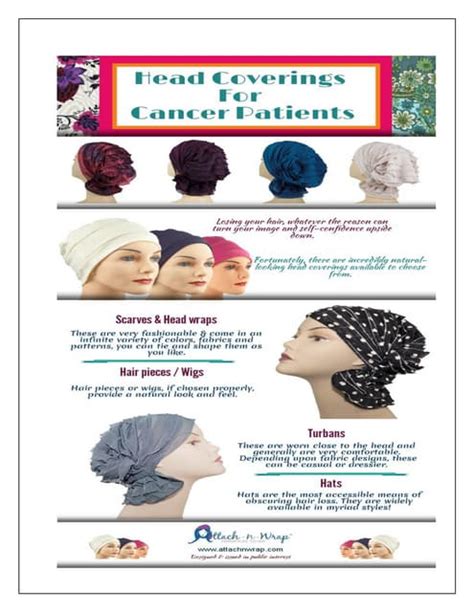Cancer treatment can have a significant impact on a person’s appearance, including hair loss. For many patients, head coverings provide a way to feel confident and in control during this challenging time. This comprehensive guide explores the various options available and offers practical tips for making the best choice.

Benefits of Head Coverings
Head coverings for cancer patients offer numerous benefits:
- Protection: Coverings shield the scalp from sun, cold, and other elements.
- Comfort: They provide a soft and soothing layer against sensitive skin.
- Privacy: They can conceal hair loss and give patients a sense of anonymity.
- Expression: Head coverings can be a way to express personal style and individuality.
Types of Head Coverings
There are a wide variety of head coverings available, including:
- Caps: Soft and stretchy, ideal for everyday wear and sleep.
- Hats: Fashionable options that come in a range of styles and materials.
- Bandanas and scarves: Versatile and easy to tie, they can be worn in multiple ways.
- Turbans: Traditional head wraps that provide full coverage and a polished look.
- Prosthetics: Artificial hairpieces that mimic natural hair.
How to Choose the Right Head Covering
Choosing the best head covering depends on individual needs and preferences. Consider the following factors:
- Comfort: Choose a material that feels soft and smooth on the scalp.
- Style: Opt for a covering that matches your personal taste and wardrobe.
- Fit: Ensure the covering stays securely in place and doesn’t slip off.
- Versatility: Consider a covering that can be worn in different ways or with other accessories.
Innovative Solutions
Beyond traditional head coverings, innovative products are emerging to address the needs of cancer patients:
- Cooling caps: Help prevent hair loss during chemotherapy by constricting blood vessels in the scalp.
- Scalp protectors: Shield the scalp from UV rays and other environmental hazards.
- Adaptive headwear: Designed with special features for cancer patients, such as adjustable straps and moisture-wicking materials.
Common Mistakes to Avoid
When selecting and wearing head coverings, avoid the following mistakes:
- Over-tightening: Tight head coverings can cause discomfort and irritation.
- Wearing the same covering for long periods: Change coverings regularly to prevent buildup of bacteria and moisture.
- Ignoring scalp care: Wash the scalp and use gentle products to maintain hygiene and prevent skin irritation.
Pros and Cons of Head Coverings
Pros:
- Comfort and protection
- Privacy and confidence
- Stylish options
- Can conceal hair loss
Cons:
- Can be uncomfortable in hot weather
- Some materials may irritate sensitive skin
- Prosthetics can be expensive
Frequently Asked Questions
1. Do I need a prescription for a head covering?
No, head coverings are not typically prescription items.
2. Can I wear a wig without a cap?
Yes, but a cap provides an extra layer of comfort and helps secure the wig.
3. How often should I wash my head covering?
Wash head coverings regularly to maintain hygiene and prevent bacteria buildup.
4. Are there insurance options for head coverings?
Some insurance plans may cover certain types of head coverings, such as cooling caps.
5. Can I wear head coverings after my hair grows back?
Yes, some people continue to wear head coverings after hair regrowth for comfort or style reasons.
6. Where can I find support for choosing and wearing head coverings?
There are online support groups and resources available for cancer patients and caregivers.
Conclusion
Head coverings for cancer patients are an important part of the recovery journey, providing both practical and emotional support. With the wide variety of options available, there is a covering that can meet the needs and preferences of every patient. By embracing the benefits and avoiding common mistakes, cancer patients can find comfort, style, and confidence in their head coverings.
